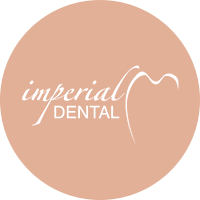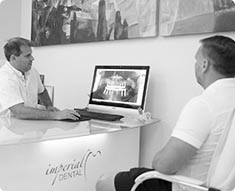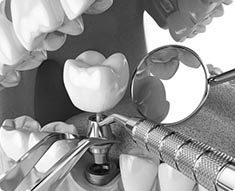Zahnersatz - Kronen
Teeth have many tasks in our daily lives. Teeth are used chiefly for biting or chewing food, but they also help in the shaping of sounds, forming of words in speech and creating face harmony. Thus replacing missing teeth is very important in case of only one missing tooth as well.
The prosthesis are not only responsible for the replacement of missing teeth, they help to avoid functional and aesthetic disorders, and prevent later lesions caused by lost teeth. Lack of one or more teeth can disrupt the normal dentition and it can indicate the moving of remaining teeth into the empty space that can lead to further problems.
Loosening Of Teeth | Causes
- tooth decay
- periodontal inflammation
- normal age-related atrophy of mandible
- trauma
Missing Teeth | Consequences
- a decline in chewing ability
- periodontal disease that affects more and more teeth
- overloading of the remaining teeth that cause dental abrasion
- the prominence of the remaining teeth
- drifting and inclination of adjacent remaining teeth
- pain in mandibular joint
- digesting system diseases
- dysphonia
- aesthetic disadvantage
- altered facial expression
- psychological inhibitions
Dentures | Divided Into 2 Groups
Fixed prosthetics (crown, bridge, denture, post-crown)
Fixed prosthetics mean carefully prepared, not removable replacements attached to remaining teeth or dental implants. They need dental intervention to remove them. It is important to note that a fixed prosthesis is damaged during removal, so the removed prosthesis cannot be placed back into the mouth. Fixed restorations: crowns, bridges, root canal pin prosthesis.
Removable dentures (partial, full)
If a denture substitutes all teeth of a jaw, it is called a full removable denture. Removable partial denture replaces only the missing teeth when some of the natural teeth still remain. The replacement teeth of dentures are usually attached to a gum-coloured plastic base, which is connected by metal framework that holds the denture in place in the mouth. Removable partial dentures can be attached to natural teeth with metal clasps or devices called precision attachments.
They can be removed without dental intervention.
Aesthetic Dentures, Crowns | Routine Dental Procedures
When the functions of a tooth (chewing, aesthetic) cannot be restored with filling or inlay, a crown is warranted. In our dental clinic, it is a routine procedure to make natural looking, aesthetic dental crowns, bridges, and dentures. Crowns are full restorations they cover the whole surface of a tooth and protect the tooth from breaking. Crowns do not discolour and they are durable and resistant.
Crowns | Preparation According To Modern Rules
Crowns are grinded by a special technique called shoulder preparation. It means that the dentist prepares a shoulder around the tooth at the gum line level. Thus the crown perfectly fit the grinded tooth at the shoulder. This technique is much more precise than traditional tangential preparation because the line where the crown meets the toot remains invisible and doesn't cause any irritation.
Dentures | Materials
The most common type of crown is made of porcelain fused to metal. It means that a porcelain layer burnt on a thin metal cap. Ultimately, only the porcelain is visible. It is a very durable prosthesis but lacks the transparency of the natural teeth. Metal-free crowns look as natural as real teeth. They are strong, wear-resistant, durable and also aesthetic restorations. Considering the technology it may be (Bell Glass, Empress) pressed ceramic or (CAD-CAM technology) procera crown.
Aesthetic Dentistry | Replacement Of Missing Teeth
Bridges are one way of replacing missing teeth, adjacent teeth are used to support the dental prosthesis. The most common material of dental bridges is porcelain fused to metal since it is strong enough to withstand chewing loads. Metal-free materials can be used in case of smaller dentures, such as procera bridges with CAD-CAM technology.
Bridges | Materials
There are two types of materials for dental bridges:
Metal-ceramic
It is durable in case of more missing teeth for a long time due to its metal structure. With a special technique, a porcelain layer is burnt onto this metal frame to make an aesthetically perfect bridge. The disadvantage of this type is the allergic effects of metals.
Metal-free zirconia
It does not contain any metal. The bridge frame is made up of zirconium oxide which is four times stronger than metal. It also can be used in case of metal allergy and with an aesthetically perfect result.
Special Type Of Bridges | Inlays
This special type of bridges is recommended in the case when the adjacent teeth have fillings or tooth decay. Instead of grinding the adjacent teeth, only a small cavity will be prepared in the place of tooth decay or filling. It is necessary to prepare a small cavity in both adjacent teeth to support the bridge. Finally, the bridge is bonded into both prepared cavities with a special adhesive material.
On the one hand, this type of bridges can replace the missing teeth, on the other hand, the inlays aesthetically replace the missing tooth tissue. The biggest advantage of these inlay-anchorage bridges is that it's not necessary to grind the adjacent teeth, but its disadvantage is that it's not suitable in case of multiple missing teeth.
Metal-free Dentures | Aesthetics Above All
When aesthetics are essential, a metal-free prosthesis is recommended especially in the front teeth area.
Zirconia Crowns | What Is Zirconium-oxide?
The zirconium (zircon) is a chemical element with atomic number 40 located in the group of metals. It is a very hard, high strength and solid material and also highly resistant to corrosion. The most common oxide is zirconium dioxide, also referred to as zirconia.
Zirconium-oxide | Characteristic
Zirconia is a very hard material and it has a high flexural strength which makes it very resistant. Zirconia doesn't corrode because it is chemically inert. In order to achieve these properties, zirconium-oxide has to undergo an advanced manufacturing process, so its bending strength can be increased tenfold as compared to that of porcelain. Therefore it could not be used in dentistry for a long time because of the absence of suitable technique. The breakthrough was the appearance of CAD / CAM systems in the early 1990s, which means a perfect process of zirconium oxide.
Zirconia Crowns | Fitting Technique
Porcelain fused to zirconia crowns can be used only with shoulder preparation technique to ensure the protection of the gums and avoid the possibility of gum recession and inflammation.
Zirconia Crowns | Benefits
- completely metal-free
- look exactly like real teeth
- no allergic reactions
- no cold/hot sensitivity
- strong enough for molar teeth
- no dark lines at the gum line
- no discolouration
- high resistance
- very hard, tooth-coloured material
- precise fit thanks to the CAD / CAM technology
- no gum inflammation (gingivitis) or gum recession due to shoulder preparation
- suitable for bridges thanks to its strong frame
Cad / Cam Technology | High-tech Dentistry
In today's modern dentistry, the rapid development of computer technology has made possible the utilization and processing of zirconium oxide. Processing of high strength zirconium-oxide wasn't possible with the conventional laboratory techniques. The appearance of CAD / CAM systems means the breakthrough technology of dental labs.


 Flughafentransfer
Flughafentransfer Individueller, detaillierter Behandlungsplan
Individueller, detaillierter Behandlungsplan VollstÃĪndige Implantatberatung und zahnÃĪrztliche Untersuchung
VollstÃĪndige Implantatberatung und zahnÃĪrztliche Untersuchung PanoramarÃķntgen des gesamten Mundes
PanoramarÃķntgen des gesamten Mundes Computergesteuerte Bissanalyse
Computergesteuerte Bissanalyse
